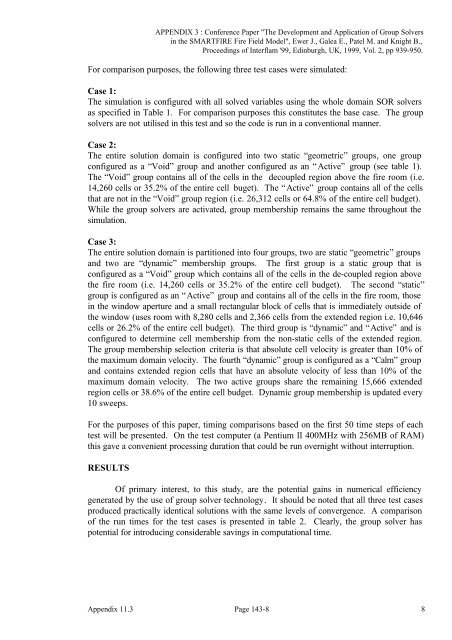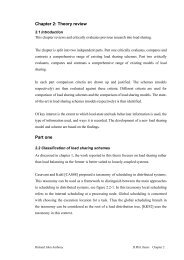PhD Thesis - staffweb - University of Greenwich
PhD Thesis - staffweb - University of Greenwich
PhD Thesis - staffweb - University of Greenwich
Create successful ePaper yourself
Turn your PDF publications into a flip-book with our unique Google optimized e-Paper software.
APPENDIX 3 : Conference Paper "The Development and Application <strong>of</strong> Group Solversin the SMARTFIRE Fire Field Model", Ewer J., Galea E., Patel M. and Knight B.,Proceedings <strong>of</strong> Interflam '99, Edinburgh, UK, 1999, Vol. 2, pp 939-950.For comparison purposes, the following three test cases were simulated:Case 1:The simulation is configured with all solved variables using the whole domain SOR solversas specified in Table 1. For comparison purposes this constitutes the base case. The groupsolvers are not utilised in this test and so the code is run in a conventional manner.Case 2:The entire solution domain is configured into two static “geometric” groups, one groupconfigured as a “Void” group and another configured as an “Active” group (see table 1).The “Void” group contains all <strong>of</strong> the cells in the decoupled region above the fire room (i.e.14,260 cells or 35.2% <strong>of</strong> the entire cell buget). The “Active” group contains all <strong>of</strong> the cellsthat are not in the “Void” group region (i.e. 26,312 cells or 64.8% <strong>of</strong> the entire cell budget).While the group solvers are activated, group membership remains the same throughout thesimulation.Case 3:The entire solution domain is partitioned into four groups, two are static “geometric” groupsand two are “dynamic” membership groups. The first group is a static group that isconfigured as a “Void” group which contains all <strong>of</strong> the cells in the de-coupled region abovethe fire room (i.e. 14,260 cells or 35.2% <strong>of</strong> the entire cell budget). The second “static”group is configured as an “Active” group and contains all <strong>of</strong> the cells in the fire room, thosein the window aperture and a small rectangular block <strong>of</strong> cells that is immediately outside <strong>of</strong>the window (uses room with 8,280 cells and 2,366 cells from the extended region i.e. 10,646cells or 26.2% <strong>of</strong> the entire cell budget). The third group is “dynamic” and “Active” and isconfigured to determine cell membership from the non-static cells <strong>of</strong> the extended region.The group membership selection criteria is that absolute cell velocity is greater than 10% <strong>of</strong>the maximum domain velocity. The fourth “dynamic” group is configured as a “Calm” groupand contains extended region cells that have an absolute velocity <strong>of</strong> less than 10% <strong>of</strong> themaximum domain velocity. The two active groups share the remaining 15,666 extendedregion cells or 38.6% <strong>of</strong> the entire cell budget. Dynamic group membership is updated every10 sweeps.For the purposes <strong>of</strong> this paper, timing comparisons based on the first 50 time steps <strong>of</strong> eachtest will be presented. On the test computer (a Pentium II 400MHz with 256MB <strong>of</strong> RAM)this gave a convenient processing duration that could be run overnight without interruption.RESULTSOf primary interest, to this study, are the potential gains in numerical efficiencygenerated by the use <strong>of</strong> group solver technology. It should be noted that all three test casesproduced practically identical solutions with the same levels <strong>of</strong> convergence. A comparison<strong>of</strong> the run times for the test cases is presented in table 2. Clearly, the group solver haspotential for introducing considerable savings in computational time.Appendix 11.3 Page 143-8 8




